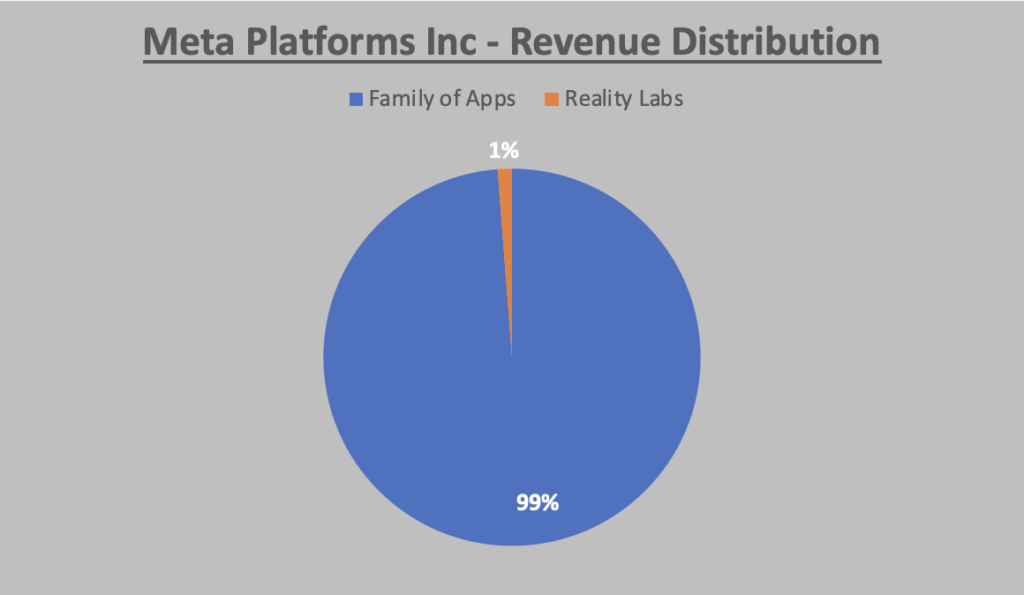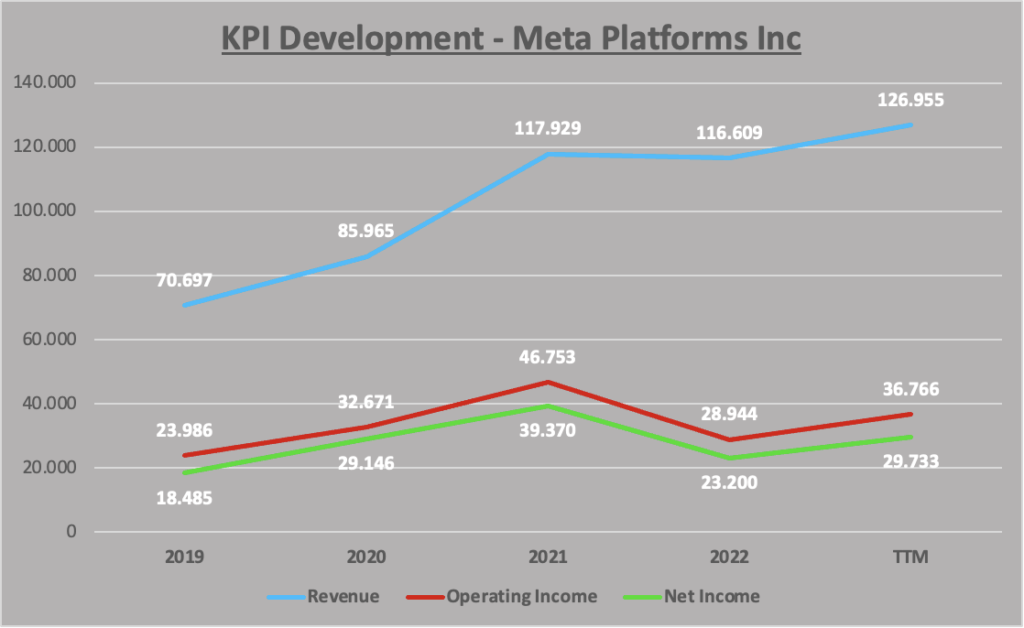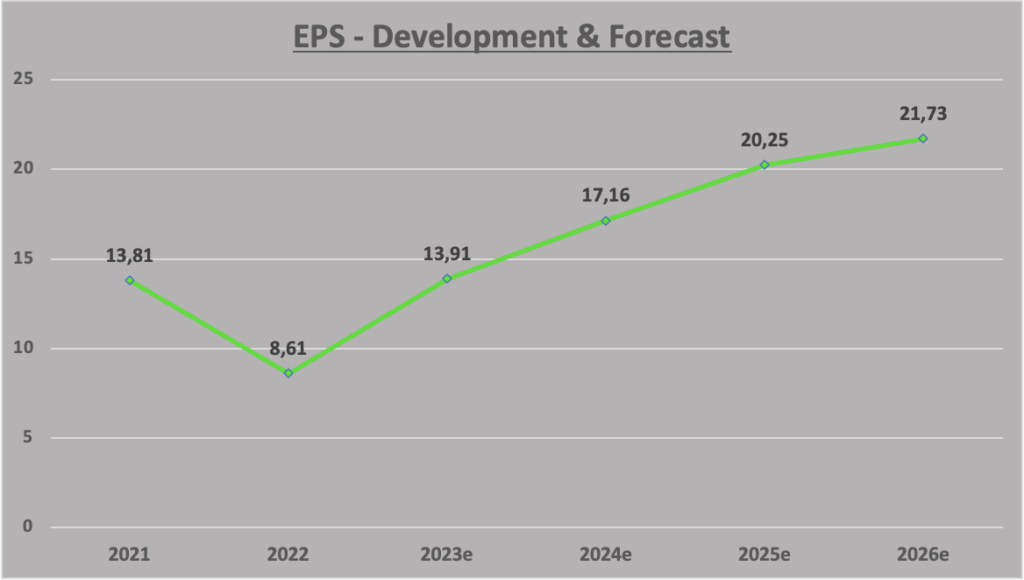In this stock analysis we will learn everything about the Meta Platforms share. We will analyze Meta’s profitability, financial security & growth and in the end we will evaluate the share price. You can then decide whether Meta Platforms is a suitable investment for you or not.
Company profile
Meta Platforms (formerly Facebook, Inc.) is a US multinational technology company based in Menlo Park, California. The company’s main products are the Facebook website and mobile app, the Instagram and WhatsApp mobile apps. Meta also owns and operates several other companies, including:
- Reality Labs: This division develops virtual reality (VR) and augmented reality (AR) products, including the Oculus Quest headset and Ray-Ban Stories smart glasses.
- Meta AI: This division develops artificial intelligence (AI) technology, including machine learning, natural language processing and computer vision.
- Metaverse: This is a new initiative that aims to create a virtual world where people can interact with each other and with digital objects in a more immersive way.
Meta Platforms is led by Mark Zuckerberg, who is the founder and CEO of the company. Zuckerberg is a controversial figure, but also one of the most successful entrepreneurs in history.
Meta Platforms faces a number of challenges, including increasing competition from other technology companies, regulatory scrutiny and criticism of its handling of user data. However, the company is also investing heavily in new technologies, such as VR and AR, and is betting that these technologies will be the future of the internet.
Revenue distribution – Meta Platforms
Meta’s sales break down as follows:

The Reality Labs and other Meta Platforms projects, such as Meta AI and the Metaverse, do not play a major role in sales. The Family of Apps includes the social networks of Facebook, Instagram, WhatsApp and Threads.
Revenue from the Family of Apps is almost exclusively made up of advertising revenue on the various platforms.
This dependence on the advertising industry harbors a number of risks for Meta. Firstly, the advertising industry is dependent on the general economic situation. If the economy cools down, this can lead to a decline in advertising expenditure. Secondly, the advertising industry is dependent on the competition. Meta competes with other technology companies, such as Google and Amazon, which are also active in the advertising market.
Meta is trying to diversify its revenue base by investing in new technologies, such as virtual reality and augmented reality. These technologies have the potential to create new revenue streams for the company.
Competition
Meta’s biggest competitors are other technology companies active in social media, online marketing and artificial intelligence. These include:
- Google: Google is Meta’s biggest competitor in the field of social media and online marketing. The company offers a range of products and services that compete with Meta’s products and services, including the social media platform YouTube and the online advertising platform Google Ads.
- Amazon: Amazon is another major competitor to Meta in the online marketing space through its online advertising platform Amazon Advertising.
- TikTok: TikTok is a Chinese social network that has rapidly gained popularity in recent years. The network is particularly popular with young people and poses a serious threat to Meta’s position as market leader in the social media sector. (Unfortunately, TikTok is not yet tradable on the stock exchange)
- Snapchat: Snapchat is a social network that specializes in private messages and photos. The network is particularly popular with young people and represents serious competition for Meta’s instant messaging app WhatsApp.
- Pinterest: Pinterest is a social network that specializes in inspiration and discovery. The network is particularly popular with women and poses a challenge to Meta’s position as market leader in the social media sector.
Profitability – Meta Platforms Inc
The first analysis to determine the intrinsic value is profitability.
Stocks with a competitive advantage generate high profit margins, do not require a lot of capital and stand out from the competition. In other words, stocks with a competitive advantage are more profitable than the competition.
To determine this, we first look at the income statement, analyze it, compare the profit margins with the competition and calculate how capital-intensive the business is compared to the competition.
To do this, we take a closer look at the income statement and start by analyzing how much revenue was generated, what costs accrued and what profit were achieved as a result. Here is the income statement stream from Meta Platforms:

Meta Platforms generated sales of around $127 billion in the last four quarters, with revenue costs of around $27 billion. The approximately $64 billion in operating expenses are made up of around 40% administrative costs and 60% research and development costs. The non-operating costs & earnings cancel each other out and have no effect on profits. After taxes, Meta generated a profit of $30 billion.
Profit margins in the income statement
The various margins are of particular interest in the income statement analysis. The higher the margins compared to the competition, the greater the competitive advantage. The emphasis here is on competitive comparison, as companies from the automotive industry cannot be compared with technology companies such as Meta. A comparison only makes sense if the products and services are comparable.
Meta Platforms achieves better margins than its competitors:
| Meta Platforms | Alphabet (ex Google) | Amazon | Snapchat | ||
| Gross Margin | 79% | 56% | 15% | 57% | 76% |
| Operating Margin | 29% | 27% | 5% | -32% | -11% |
| Net Profit Margin | 23% | 22% | 4% | -30% | -7% |
Margins from the income statement give us an indication of the profitability of a company. Basically, it can be said that the better the margins compared to the competition, the higher the profitability and the greater the competitive advantage.
Return on Assets
Return on assets (ROA for short) is the most important key figure for analyzing a company’s profitability. ROA is calculated by dividing the profits by the total assets. It shows how much profit a company generates from its assets. The higher the ROA compared to the competition, the better the company’s earning power.
An example to illustrate this: Let’s assume you have $500,000 to buy a rental apartment. You can choose between two apartments: The first apartment costs $500,000 and brings in $12,000 in rental income per year. The second apartment also costs $500,000 and brings in $18,000 in rental income per year.
The ROA for the first apartment is 2.4 % and 3.6 % for the second apartment. This means that you generate more income from your invested capital with the second apartment.
Here is the ROA comparison between Meta Platforms and its competitors:
| Meta Platforms | Alphabet | Amazon | Snapchat | ||
| ROA | 15,29% | 17,82% | 4,33% | -17,21% | -6,22% |
As already mentioned, the comparison is very complex because only similar products and services can be compared with each other. Meta, which generates the most revenue from advertising, would have to be compared with companies that also generate most of their revenue from advertising. Accordingly, the comparison of Meta’s ROA with Alphabet, Snapchat or Pinterest is the most meaningful.
Financial Security – Meta Platforms Inc
After analyzing the profitability, the second analysis for determining the intrinsic value is the financial security of a company. This is because companies that are financially secure and solidly financed give us investors a level of security. While the income statement provides us with information about the operating business, the balance sheet shows us how the company is financed.
To assess the financial security of a company, it is important to look at the ratio between equity and debt. In addition, the company should be able to cope with short-term financial burdens. The debt to equity ratio and the cash ratio are two key figures that can help us with this.
The debt to equity ratio shows the relationship between long-term debt and equity. The cash ratio shows how well short-term liabilities are covered by cash, bank and similar assets. Here is the development of the mentioned KPIs for Meta:
| Cash Ratio | Debt to Equity | |
| 2019 | 3,64 | 0,1 |
| 2020 | 4,14 | 0,08 |
| 2021 | 2,27 | 0,11 |
| 2022 | 1,51 | 0,21 |
This means that current liabilities are well covered and the company is largely self-financed. This is an indicator of a high level of financial security. To put financial security into perspective, here is a comparison with the competition:
| Meta Platforms | Alphabet | Amazon | Snapchat | ||
| Cash Ratio | 1,51 | 1,64 | 0,45 | 3,24 | 7,09 |
| Debt to Equity | 0,21 | 0,12 | 0,96 | 1,62 | 0,07 |
As this comparison clearly shows, Meta has a high level of financial security. Compared to its competitors, Meta’s current liabilities are the third best secured and its debt-to-equity ratio is also the third lowest.
Growth – Meta Platforms Inc
Analyzing company performance is an important part of value investing. It makes it possible to draw conclusions for the future from the past. The income statement provides important information about the development of the company.
Here is the development of revenue, operating income and net income from 2019 to TTM:

In the period from 2019 to TTM, Meta has achieved an increase in revenue of +80%, with an operational growth of +53% combined with a profit increase of +61% to around $30 billion.
Compared to the competition, Meta’s growth is doing well:
| 2019 to TTM | Meta Platforms | Alphabet | Amazon | Snapchat | |
| Revenue Growth | +80% | +84% | +97% | +165% | +158% |
| Operating Growth | +53% | +119% | +81% | N/A | N/A |
| Net Income Growth | +61% | +94% | +73% | N/A | N/A |
The development of KPIs can provide information about the future development of a company. Although past growth is no guarantee for future growth, companies with a strong performance will generally continue to grow in the future. Companies whose sales and profits are dropping, on the other hand, will generally also fall in the future. To create a more accurate forecast, you should also consider the revenue distribution in addition to the KPI development.
Share Price & Forecasts
Now that we have analyzed and evaluated the Meta share, it is time to assess the current price of the share.
The share price is determined by supply and demand. Supply is determined by the company and the shareholders. Demand is determined in the long term by the earnings per share. The more profit a share generates, the more interesting it is for investors.
The P/E ratio, also known as the price/earnings ratio, shows the relationship between the share price and the earnings per share. For example, a P/E ratio of 20 means that a share with a price of $20 has earnings per share of one dollar. (Price = P/E ratio * earnings per share)
The lower the P/E ratio, the better the investment. Unfortunately, this cannot be said across the board, as future developments and forecasts play a very important role. Let’s come back to our example:
We currently have a P/E ratio of 20 and an earnings per share of one dollar.
In the first scenario, we assume that the company will generate earnings per share of $3 next year and even more in the following years. The future prospects are therefore very good, and if this is the case, demand will probably increase.
The second scenario is exactly the opposite. Future expectations are poor and the company is expected to generate only $0.5 per share in the coming year and the following years do not look much better. Here, the share price of $20 is probably too high for many investors and demand is falling.
In the last scenario, it is expected that the company will no longer achieve growth and will remain at a profit of $1 per share in the coming years. The $20 is perhaps just the right price and a stable share for the future.
The various scenarios are purely hypothetical and only reflect reality to a certain extent. But the basic idea between earnings per share, P/E ratio and share price should have been well illustrated.
Earnings per Share – Meta Platforms Inc
Let’s take a look at the development and forecasts for Meta Platforms’ earnings per share (EPS):

EPS of $13.91 is expected for 2023 and the expected values for 2024 to 2026 also imply a significant increase in earnings. With the base value of 2023, Meta would achieve an increase of +56% to $21.73. Based on our analysis, this growth seems reasonable. But earnings per share are only half the story, let’s look at the P/E ratio.
P/E Ratio Development – Meta Platforms Inc
Here is the development of Meta’s P/E ratio from 2019 to 2022:

A P/E ratio of less than 20 is considered undervalued, a P/E ratio of more than 25 is considered overvalued. Meta Platforms has a P/E ratio of 13.97, which would mean that the share is undervalued.
Over the entire period, Meta’s average P/E ratio is around 24.27, which is basically a fair valuation. To get a more accurate valuation, we should link the P/E ratio with the EPS.
Share Price – Forecast
First, we link the EPS forecasts with the P/E ratios of Meta Platforms. In the first scenario, we assume that demand for Meta shares will remain the same over the next few years. This would result in the following share price forecasts:
| Year | EPS-Forecast | P/E Ratio | Share Price – Forecast |
| 2023e | 13,91$ | 24,27 | 337$ |
| 2024e | 17,16$ | 24,27 | 416$ |
| 2025e | 20,25$ | 24,27 | 491$ |
| 2026e | 21,73$ | 24,27 | 527$ |
Meta’s share price currently stands at $383.39 (as of 21.01.24). Based on this scenario, Meta’s share price performance looks good. To be precise, an increase in value of around 37% by 2026.
A second scenario with conservative demand, with a P/E ratio of 20-25, which can generally be considered fair, is not necessary here. The average P/E ratio is already within this range and would only lead to slightly different price forecasts.
Summary
The share analysis comes to the following conclusions:
- Revenue distribution: Meta generates the majority of its revenue from advertising income on its social media platforms.
- Profitability: Meta has high profit margins and a high return on assets.
- Financial security: Meta is financially sound and has a low level of debt.
- Growth: Meta has grown strongly in recent years.
Meta’s current share price is $383.39. Based on the earnings per share forecasts and Meta’s average P/E ratio of 24.27, this results in a potential share price increase of around 37% by 2026.
The stock is a solid company with a good future outlook, but what do you say?
Disclaimer
This article is not financial advice and does not constitute a recommendation to buy or sell stocks. The information in this article is based on the personal opinions of the author and should not be construed as investment advice.
The author assumes no liability for any damages resulting from the use of the information in this article. Readers should inform themselves independently before investing in stocks and only make an investment decision after their own examination. An investment in shares can lead to a total loss of capital.
All figures on Meta Platforms and the share are from Gurufocus.
Gurufocus offers a comprehensive and intuitive platform that simplifies our work as value investors. With comprehensive financial data and a stock screener with more than 500 filters, you can quickly find the right stocks and analyze them immediately. It is my absolute go-to tool for my stock analysis and you can test it for 7 days free of charge and see for yourself.



